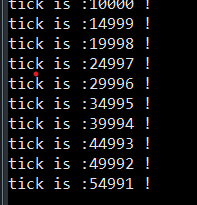rt-thread 学习(二)外部中断 添加头文件 延时函数
- 设置按键外部中断
- 开启硬件定时器
- 初始化配置部分
- 延时函数
- 添加头文件
设置按键外部中断
#include <rtthread.h>
#include <rtdevice.h>
#include "board.h"
#define DBG_TAG "main"
#define DBG_LVL DBG_LOG
#include <rtdbg.h>
#define B1_PIN_NUM GET_PIN(B,1)
/* 中断回调函数 */
void B1_IRQ_CB(void *args)
{
rt_kprintf("enter B1_IRQ_CB!\r\n");
rt_pin_write(B1_PIN_NUM, PIN_HIGH);
}
static void pin_beep_sample(void)
{
/* 按键0引脚为输入模式 */
rt_pin_mode(B1_PIN_NUM, PIN_MODE_INPUT_PULLUP);
/* 绑定中断,下降沿模式,回调函数名为beep_on */
rt_pin_attach_irq(B1_PIN_NUM, PIN_IRQ_MODE_FALLING, B1_IRQ_CB, RT_NULL);
/* 使能中断 */
rt_pin_irq_enable(B1_PIN_NUM, PIN_IRQ_ENABLE);
/* 脱离中断回调函数 */
// rt_pin_detach_irq(B1_PIN_NUM);
}
int main(void)
{
pin_beep_sample();
return RT_EOK;
}
开启硬件定时器
初始化配置部分
/** if you want to use hardware timer you can use the following instructions.
*
* STEP 1, open hwtimer driver framework support in the RT-Thread Settings file
*
* STEP 2, define macro related to the hwtimer
* such as #define BSP_USING_TIM and
* #define BSP_USING_TIM1
*
* STEP 3, copy your hardwire timer init function from stm32xxxx_hal_msp.c generated by stm32cubemx to the end of board.c file
* such as void HAL_TIM_Base_MspInit(TIM_HandleTypeDef* htim_base)
*
* STEP 4, modify your stm32xxxx_hal_config.h file to support hardwere timer peripherals. define macro related to the peripherals
* such as #define HAL_TIM_MODULE_ENABLED
*
*/
#define BSP_USING_TIM
#ifdef BSP_USING_TIM
#define BSP_USING_TIM3
void HAL_TIM_Base_MspInit(TIM_HandleTypeDef* htim_base)
{
if(htim_base->Instance==TIM3)
{
/* USER CODE BEGIN TIM3_MspInit 0 */
/* USER CODE END TIM3_MspInit 0 */
/* Peripheral clock enable */
__HAL_RCC_TIM3_CLK_ENABLE();
/* USER CODE BEGIN TIM3_MspInit 1 */
/* USER CODE END TIM3_MspInit 1 */
}
}
硬件定时器设备的具体使用方式可以参考如下示例代码,示例代码的主要步骤如下:
首先根据定时器设备名称 “timer3” 查找设备获取设备句柄。
以读写方式打开设备 “timer3” 。
设置定时器超时回调函数。
设置定时器模式为周期性定时器,并设置超时时间为 5 秒,此时定时器启动。
延时 3500ms 后读取定时器时间,读取到的值会以秒和微秒的形式显示。
#include <rtthread.h>
#define DBG_TAG "main"
#define DBG_LVL DBG_LOG
#include <rtdbg.h>
#include <rtdevice.h>
#define HWTIMER_DEV_NAME "timer3" /* 定时器名称 */
/* 定时器超时回调函数 */
static rt_err_t timeout_cb(rt_device_t dev, rt_size_t size)
{
rt_kprintf("this is hwtimer timeout callback fucntion!\n");
rt_kprintf("tick is :%d !\n", rt_tick_get());
return 0;
}
static int hwtimer_sample(void)
{
rt_err_t ret = RT_EOK;
rt_hwtimerval_t timeout_s; /* 定时器超时值 */
rt_device_t hw_dev = RT_NULL; /* 定时器设备句柄 */
rt_hwtimer_mode_t mode; /* 定时器模式 */
mode = HWTIMER_MODE_PERIOD;
timeout_s.sec = 5; /* 秒 */
timeout_s.usec = 0; /* 微秒 */
/* 查找定时器设备 */
/* 以读写方式打开设备 */
/* 设置超时回调函数 */
/* 设置模式为周期性定时器 */
/* 设置定时器超时值为5s并启动定时器 */
hw_dev = rt_device_find(HWTIMER_DEV_NAME);
ret = rt_device_open(hw_dev, RT_DEVICE_OFLAG_RDWR);
rt_device_set_rx_indicate(hw_dev, timeout_cb);
ret = rt_device_control(hw_dev, HWTIMER_CTRL_MODE_SET, &mode);
rt_device_write(hw_dev, 0, &timeout_s, sizeof(timeout_s));
return ret;
}
/* 导出到 msh 命令列表中 */
MSH_CMD_EXPORT(hwtimer_sample, hwtimer sample);
int main(void) {
hwtimer_sample();
return RT_EOK;
}
内部,外部都是这样

然后把 字符全删了就正常了

延时函数
rt_thread_delay延时的单位是系统节拍,如果每秒系统节拍数这个配置不是1000,延时数值的单位就不是毫秒,
rt_thread_mdelay可以直接使用,单位就是毫秒,无需考虑转换
添加头文件
右键工程,属性-------c/c++常规-----路径与符号-------添加,就可以把头文件路径添加到工程
